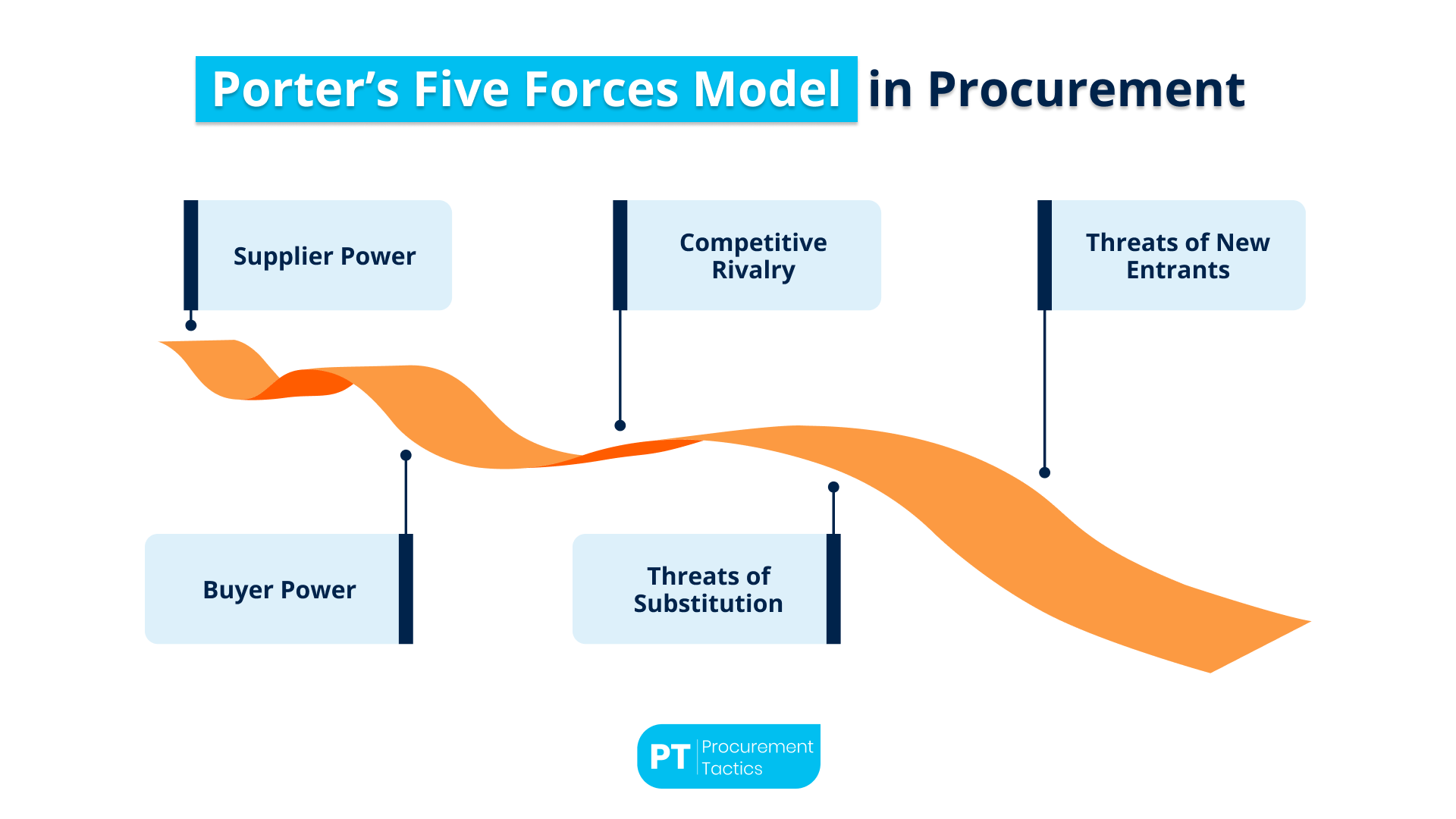Written by Marijn Overvest | Reviewed by Sjoerd Goedhart | Fact Checked by Ruud Emonds | Our editorial policy
Porter’s Five Forces Model in Procurement — Explained + Template

As taught in the Junior Procurement Management Course / ★★★★★ 4.9 rating
What is the Porter’s five forces model?
- Porter’s 5 forces is a framework used to assess an organization’s competitive strength and market position.
- This business model helps plot the necessary traits a company must possess in a competitive market.
- The five points discuss the external and internal forces that affect a company’s business position.
What Exactly is Porter’s Five Forces Model?

Porter’s 5 Forces is actually Michael E. Porter’s Five Forces of Competitive Position Analysis. Developed in 1979, its simple framework is used for assessing and evaluating the competitive strength and position of a business organization.
The concept promotes five forces that determine the competitive intensity and attractiveness of a market. So if we were to create a simple statement, Porter’s 5 forces help procurement managers in identifying where power lies during a business situation. With Porter’s 5 Forces, the following can be determined within the organization:
- Understanding how strong an organization’s competitive position is currently
- how the company can achieve a competitive advantage over its rivals
Today, Porter’s 5 Forces are now used by numerous procurement management to gain an edge over their competition. When they need to create new procurement processes that will help them get the highest quality supplies, they often rely on these five points of power
Porter’s Five Forces Model– The Five Points of Power

And now we come to the part where every procurement manager is often interested in learning about like procurement analytics. We have Porter’s 5 Forces, each point of power explained as closely as explained by Michael E. Porter himself.
1. Supplier Power
An assessment of how easy it is for suppliers to drive up prices. This is determined by the number of suppliers for each essential element; the uniqueness of their product or service; the relative size and strength of the supplier; and the cost of switching from one supplier to another.
For instance, Apple uses OLED screens for its products, but there are only a few suppliers for it. Due to the limited suppliers and switching costs are high, the suppliers have strong power to negotiate pricing and terms in this situation.
2. Buyer Power
An assessment of how easy it is for buyers to drive prices down. This is determined by: the number of buyers in the market; the importance of each individual buyer to the business; and the cost to the buyer of switching from one supplier to another. If a business has just a few powerful buyers, they are often able to dictate terms.
A perfect example for this would be: In the airline industry, large travel agencies and corporate clients can negotiate lower ticket prices because they buy in bulk and can easily switch to competitors like Delta or American Airlines if prices rise.
3. Competitive rivalry
The main driver is the number and capability of competitors in the market. If there are many competitors offering undifferentiated products and services, this will reduce market attractiveness.
An example of this would be: The fast-food industry, especially between McDonald’s, Burger King, and Wendy’s, which shows intense competition. Each brand competes on price, promotions, and product offerings to maintain its market share. This ongoing battle for dominance reduces profit margins and creates a highly competitive environment.
4. Threats of substitution
Where close substitute products exist in a market, it increases the likelihood of customers switching to alternatives in response to price increases. This reduces both the power of suppliers and the attractiveness of the market.
For example, before, traditional taxis dominated urban transport. Now, ride-sharing apps like Uber and Lyft pose a significant threat as they often provide a cheaper, more convenient, and tech-enabled service to the people. Hence, traditional taxi services have seen declining demand, forcing them to adapt or lose market relevance.
5. Threats of new entrants
Profitable markets attract new entrants, which in turn reduces profitability. Unless incumbents have strong and durable barriers to entry – for example, patents, economies of scale, capital requirements, or government policies – then profitability will decline to a competitive rate.
For instance, in the streaming industry, Netflix initially dominated. But the success of the model attracted new entrants like Disney+, HBO Max, and Amazon Prime Video. These new players eroded Netflix’s market share due to low entry barriers like digital infrastructure and wide internet access.
Porter’s Five Forces Model in Procurement
Porter’s Five Forces model is used in procurement to better understand supplier markets, evaluate risks, and make smarter sourcing decisions.
Each “force” helps procurement teams figure out how much power they have or how much risk they face when dealing with suppliers and vendors. Here’s how it’s applied:
1. Supplier Power — Understanding Supplier Leverage
Procurement teams use this force to assess how much power suppliers have over them. If there are only a few suppliers for a critical material, those suppliers can demand higher prices, stricter contracts, or longer lead times.
For example, if you’re sourcing microchips and there are only two major suppliers globally, you have very little negotiation power. To manage this, procurement teams might look for alternative suppliers, negotiate longer-term contracts to lock in prices, or even develop partnerships to secure supply.
2. Buyer Power — Understanding Your Own Leverage
For this situation, procurement teams are the “buyer,” so this force measures how strong their negotiating position is. If procurement teams buy large volumes or can easily switch suppliers, then they have high power.
For instance, a large retailer like Walmart can demand lower prices from suppliers because it buys in massive quantities.
Procurement teams leverage this by running competitive bidding processes, demanding discounts, or asking for customized services at no extra cost.
3. Competitive Rivalry — Assessing Supplier Competition
This looks at how fiercely suppliers compete with each other. If competition among suppliers is high, procurement teams can get better deals because suppliers are fighting to win the business.
Procurement teams use this force to create bidding wars to lower costs, identify which suppliers are more innovative or aggressive, as well as take advantage of seasonal or market-driven discounts.
4. Threat of New Entrants — Looking at Market Changes
This evaluates how easily new suppliers can enter the market. If it’s easy for new companies to become suppliers, for example, in basic commodities like cotton fabric, procurement can benefit from increased competition.
For instance, if a new supplier enters the market and offers lower prices for raw materials of the same quality, procurement teams can leverage this situation to negotiate better terms with their current suppliers. They may also consider switching to the new supplier if it proves to be advantageous.
5. Threat of Substitutes — Finding Alternatives
This force helps procurement think about whether other products, materials, or technologies could replace what they are currently buying. If substitutes exist, procurement teams have more choices and bargaining power.
Procurement teams use this force to source alternative materials (e.g., using recycled materials instead of new ones), reduce reliance on a single type of supply, or innovate sourcing strategies to cut costs or improve sustainability.
Conclusion
In conclusion, Porter’s 5 Forces model proves to be a pivotal tool for procurement managers seeking to gain a competitive edge in the procurement landscape.
By meticulously evaluating the dynamics of supplier power, buyer power, competitive rivalry, threats of substitution, and threats of new entrants, procurement managers can decipher the intricacies of their competitive position and make informed decisions.
This article sheds light on the significance of Porter’s 5 Forces in procurement process development, emphasizing its role in identifying sources of power and threats within the market.
As a result, procurement managers can utilize this valuable information to formulate robust procurement plans, understand industry profitability factors, make informed decisions on industry entry, and devise effective competitive strategies.
For those eager to master the application of Porter’s 5 Forces in procurement, the Negotiation Course For Procurement Professionals stands as an invaluable resource.
Enrolling in this course provides an opportunity to delve deeper into the nuances of Porter’s 5 Forces model, equipping procurement professionals with the knowledge and skills needed to navigate the complex landscape of competitive procurement successfully.
Frequentlyasked questions
What is Porter's Five Forces model?
Porter’s 5 Forces is a framework used to assess an organization’s competitive strength and market position.
How can Porter's Five Forces benefit procurement managers?
It helps procurement managers understand market dynamics and develop effective procurement strategies.
What are the five points of power in Porter's Five Forces?
The five points of power are Supplier Power, Buyer Power, Competitive Rivalry, Threat of Substitution, and Threat of New Entrants.
About the author
My name is Marijn Overvest, I’m the founder of Procurement Tactics. I have a deep passion for procurement, and I’ve upskilled over 200 procurement teams from all over the world. When I’m not working, I love running and cycling.






